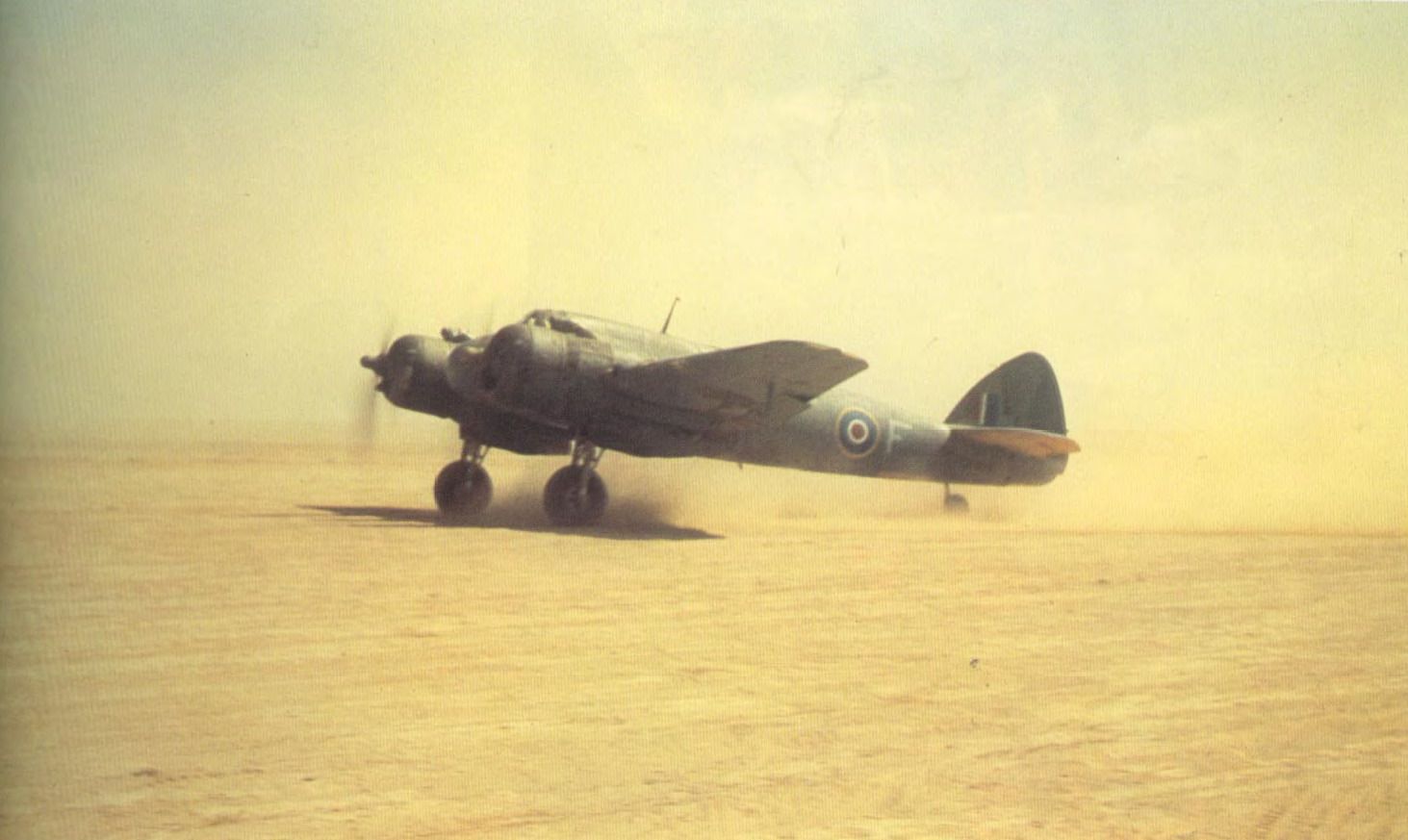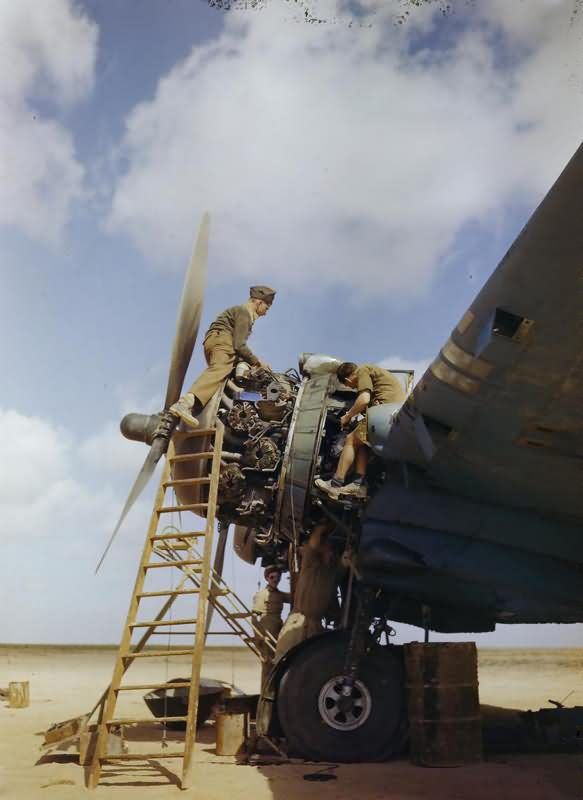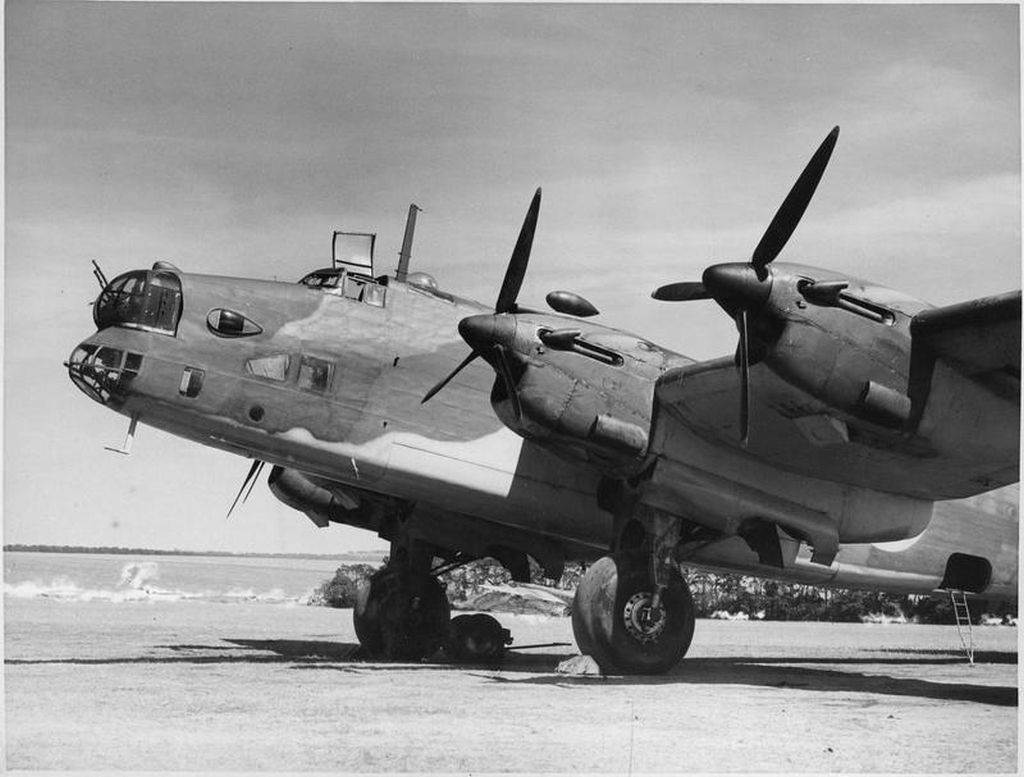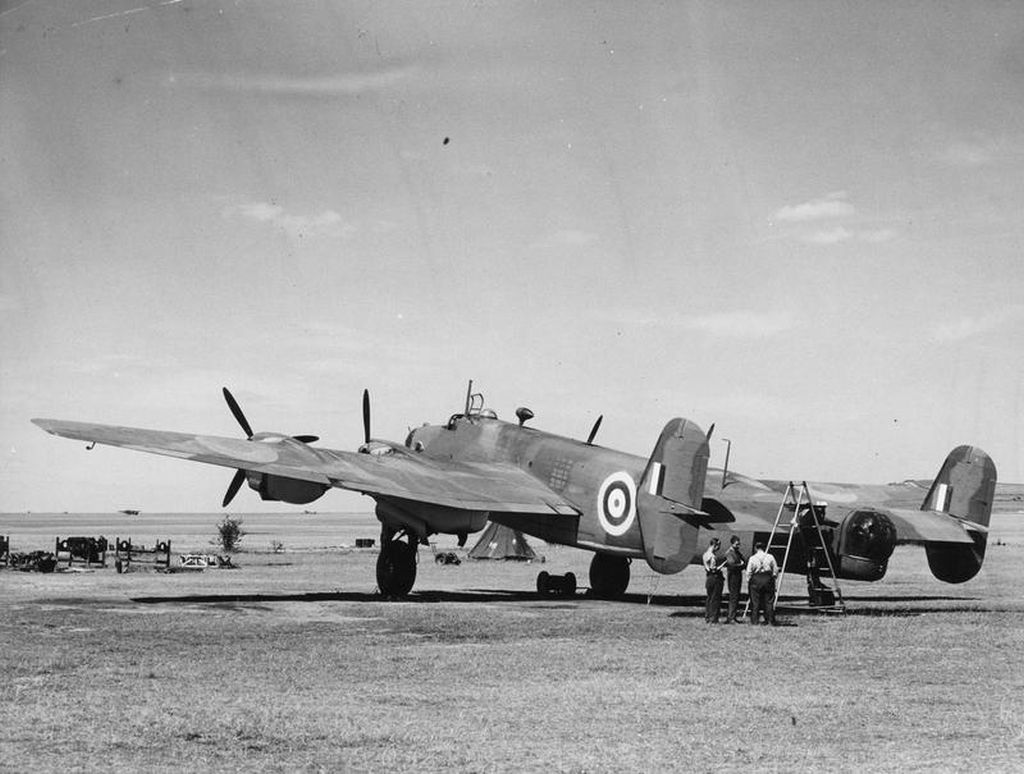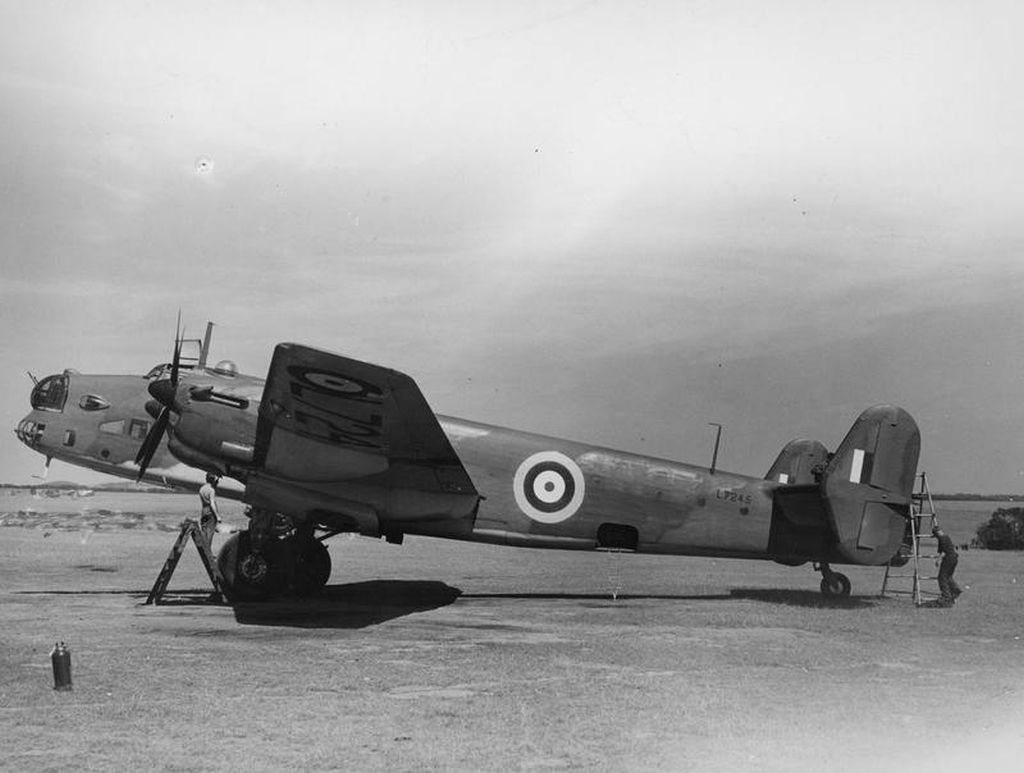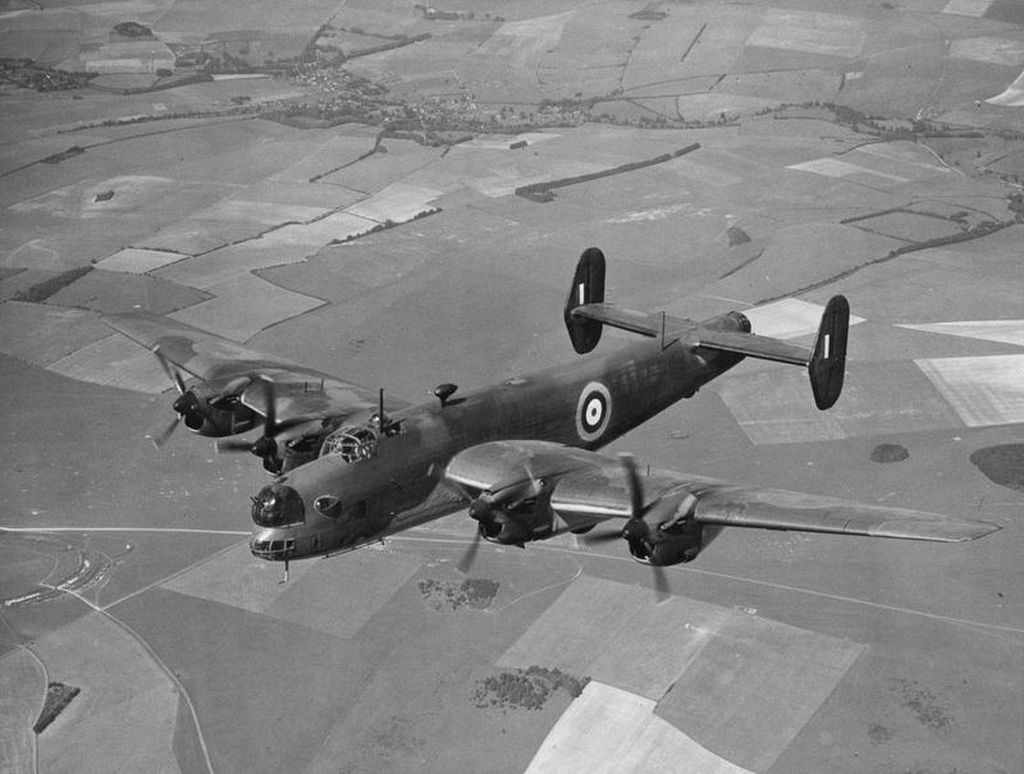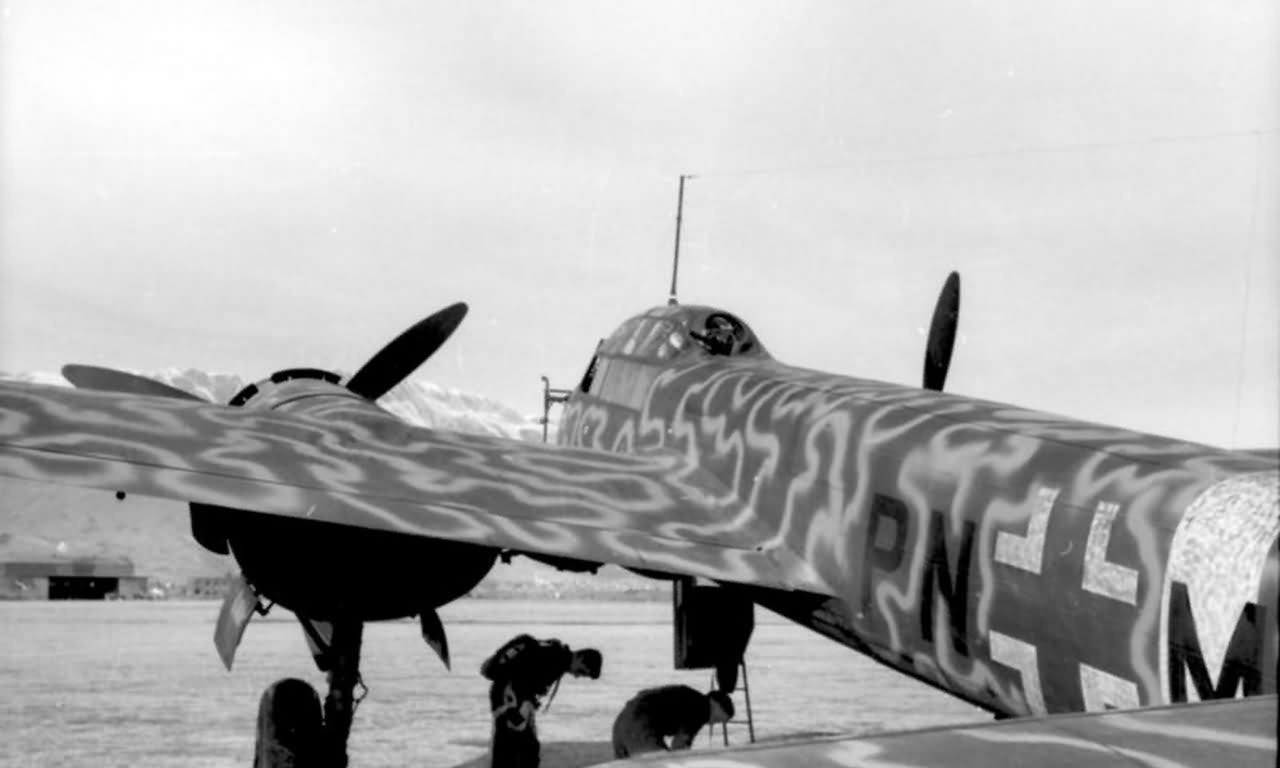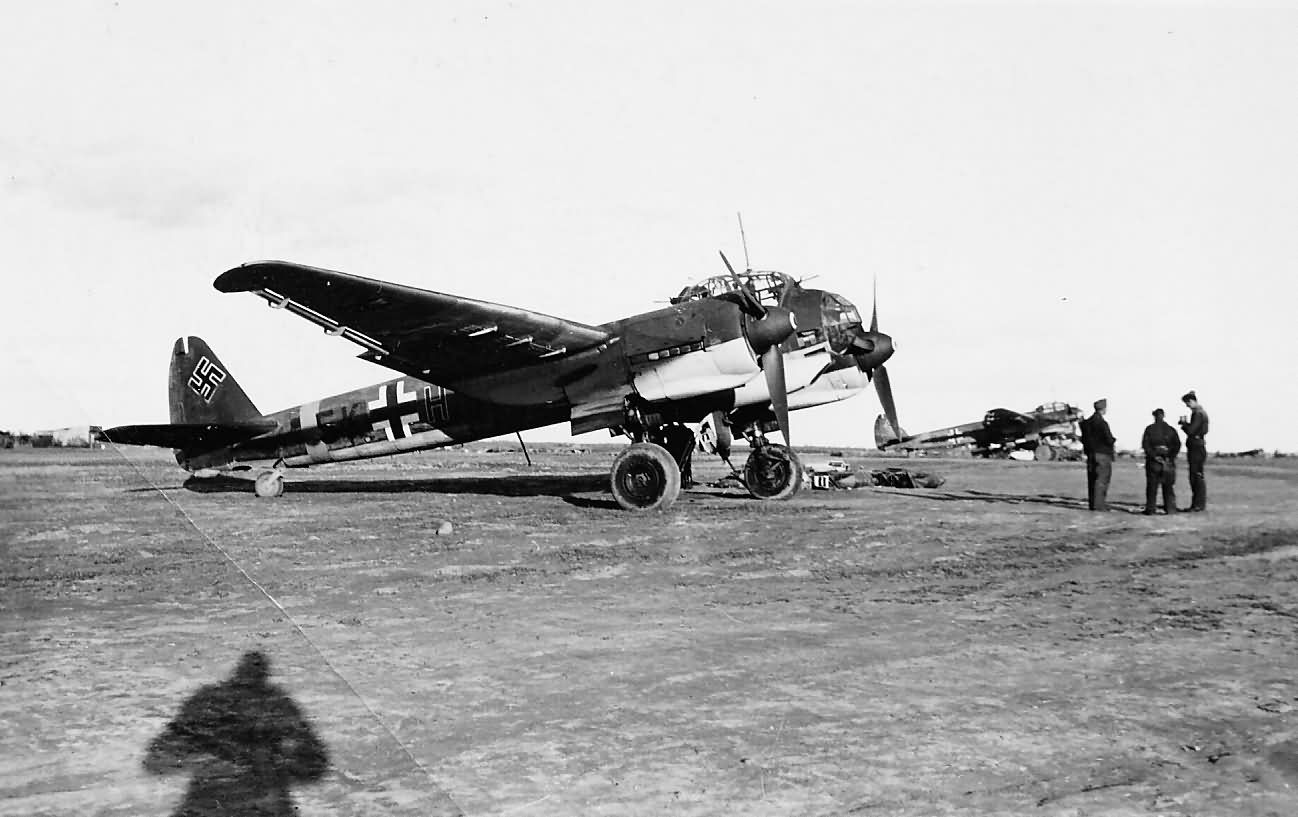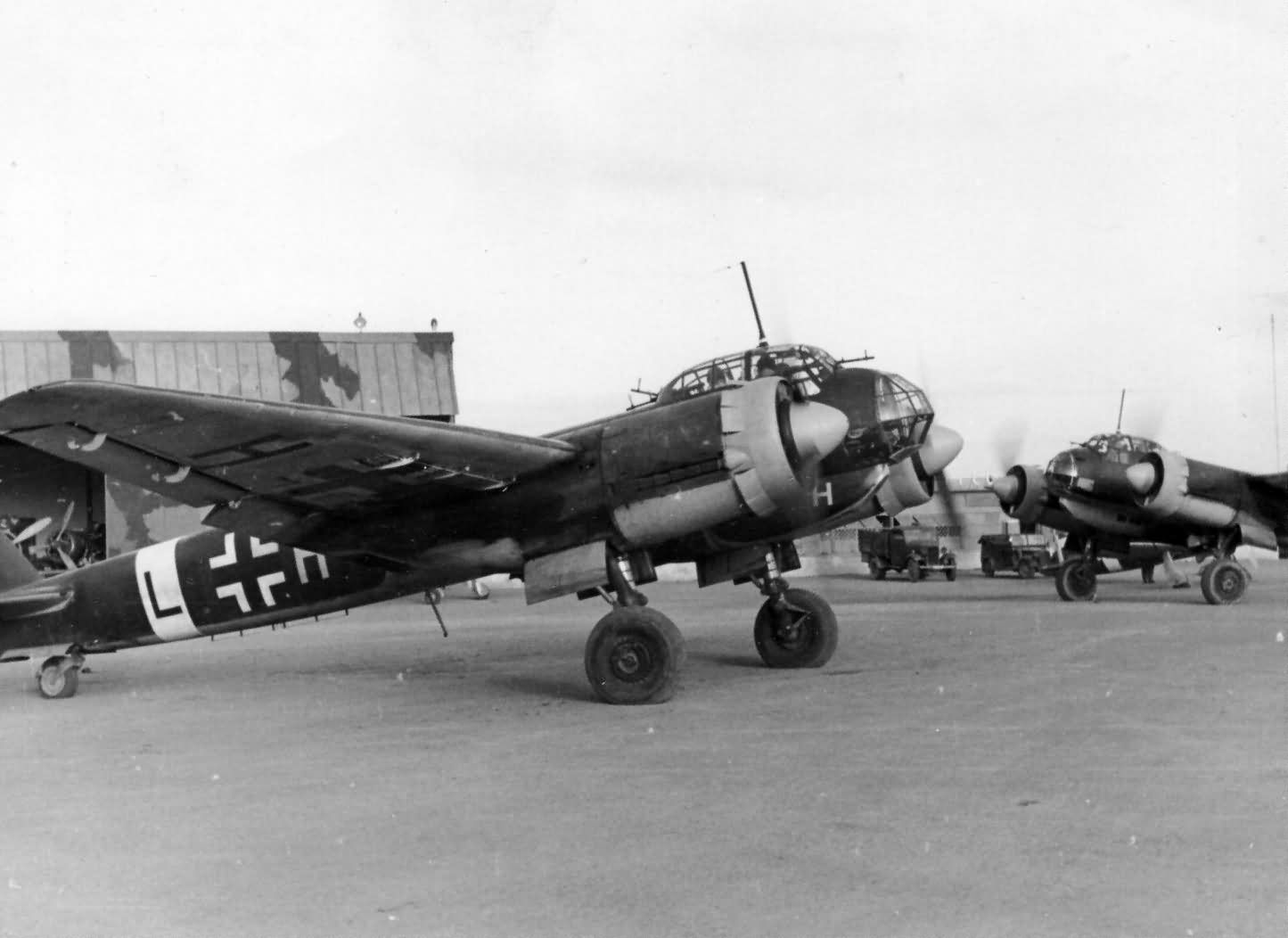Forums
- Forums
- Axis And Allies Forum
- General Discussion
- Photo of the week
Photo of the week
Post a reply
- Go to Next topic
- Go to Welcome
- Go to Introduce Yourself
- Go to General Discussion
- Go to Screenshots, Images and Videos
- Go to Off topic
- Go to Works in Progress
- Go to Skinning Tips / Tutorials
- Go to Skin Requests
- Go to IJAAF Library
- Go to Luftwaffe Library
- Go to RAF Library
- Go to USAAF / USN Library
- Go to Misc Library
- Go to The Ops Room
- Go to Made in Germany
- Go to Campaigns and Missions
- Go to Works in Progress
- Go to Juri's Air-Raid Shelter
- Go to Campaigns and Missions
- Go to Works in Progress
- Go to Skinpacks
- Go to External Projects Discussion
- Go to Books & Resources
-
 Main AdminSix this week from the IWM collection
Main AdminSix this week from the IWM collection
Squadron Leader J A Bushbridge, the Commanding Officer of No. 34 Squadron RAF, briefs his pilots at Palel, Burma, before taking off on another sortie.
A Republic P-47D Thunderbolt of the 80th Fighter Group, 10th USAAF, taxies past Hawker Hurricane Mark IIC, LB395 'L' of No. 34 Squadron RAF, at Palel, Burma.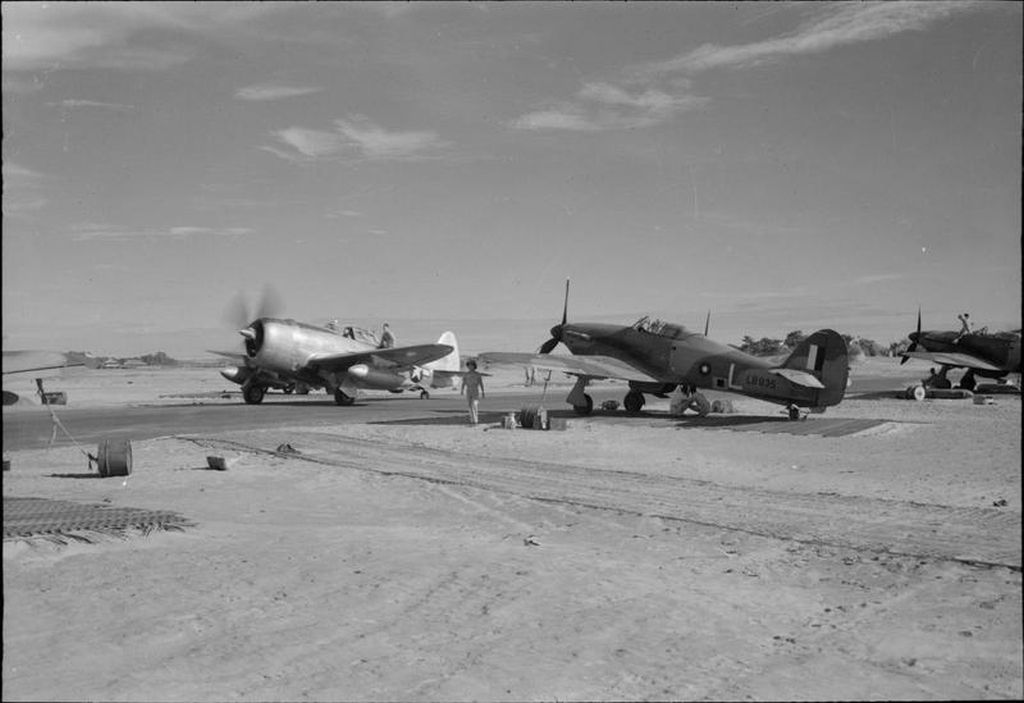
RAF ground crew unload 500-lb GP bombs from trolleys in front of a Hawker Hurricane Mark IIC of No. 221 Group RAF, which is undergoing re-arming of its four 20mm cannon at Palel, Burma.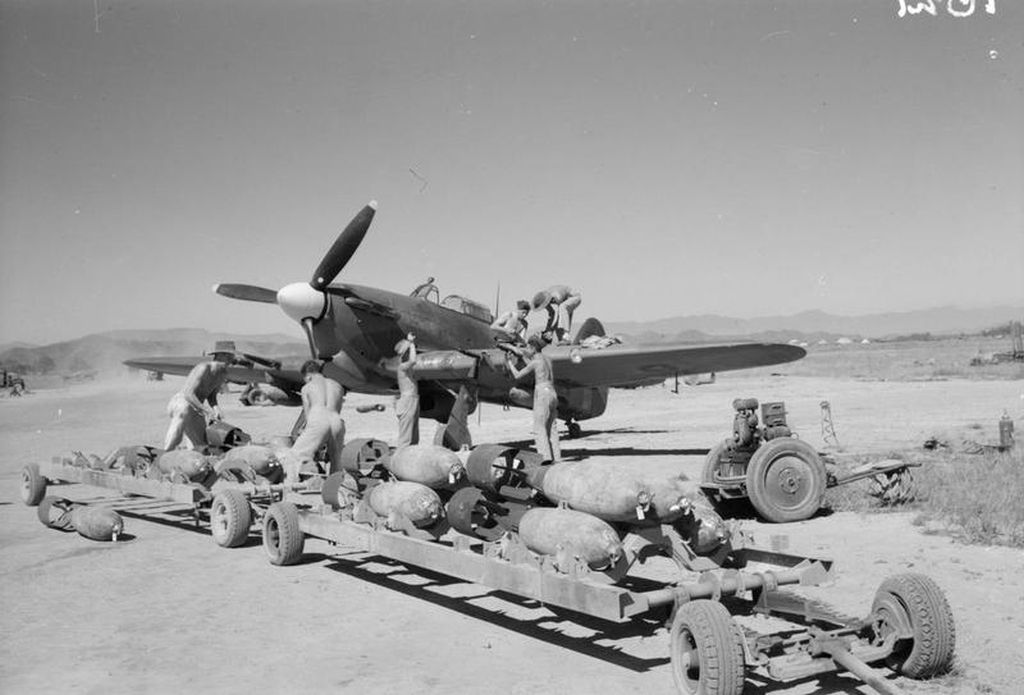
A Hawker Hurricane Mark IIC of No. 221 Group RAF, loaded with two 250-lb GP bombs, taxying before taking off on a sortie at Palel, Burma.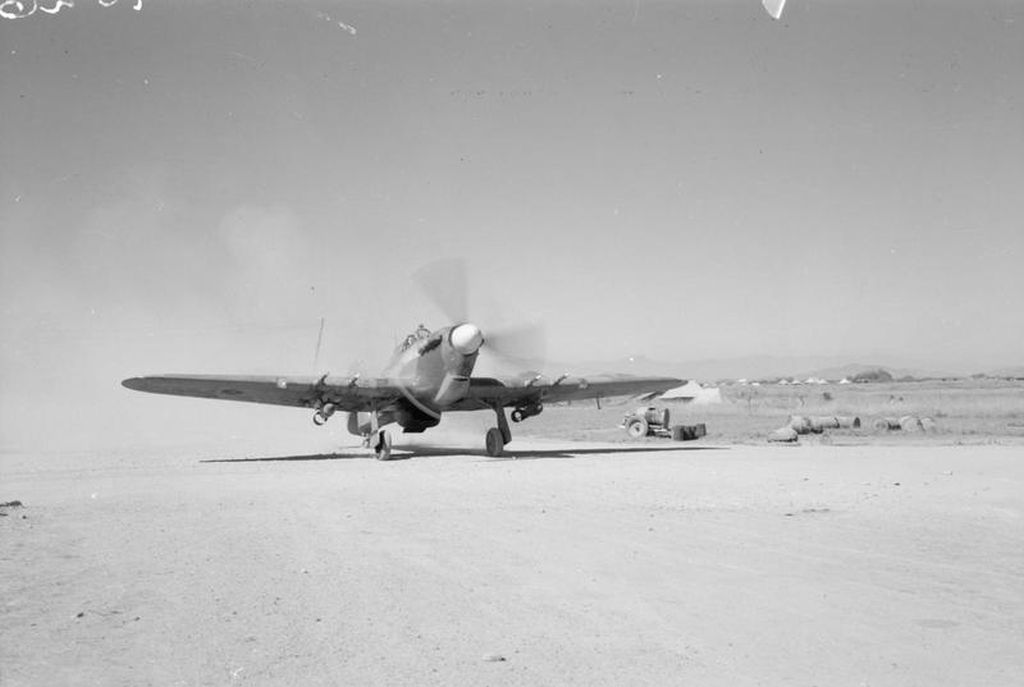
A Supermarine Spitfire Mark VIII of No. 155 Squadron RAF, creates a cloud of dust as the pilot opens up his throttle prior to take of at Tabingaung, Burma.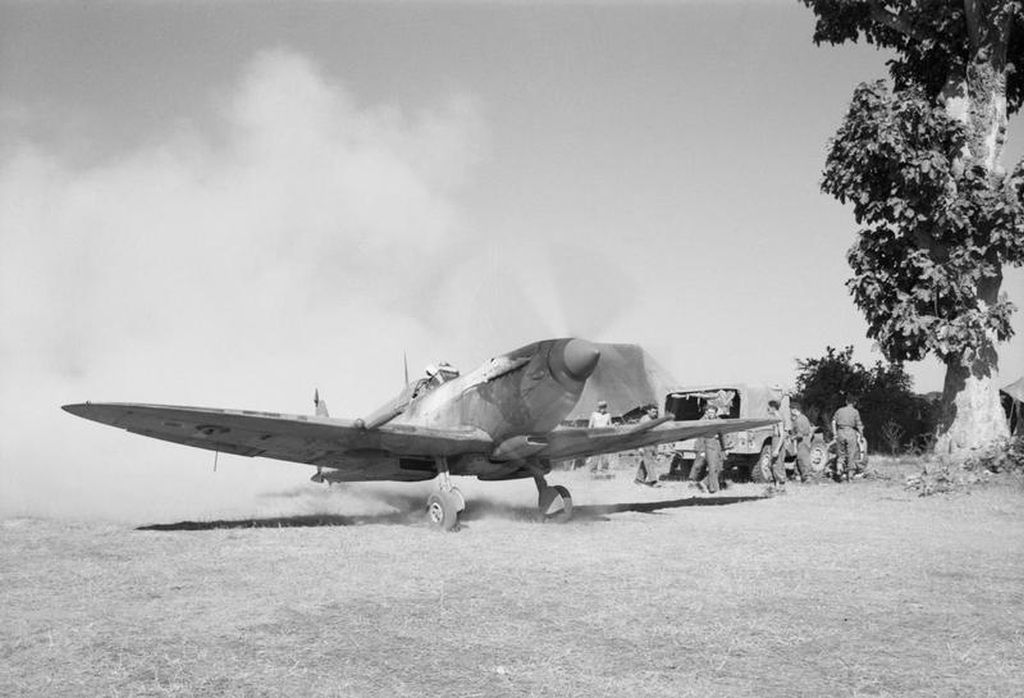
Supermarine Spitfire LF Mark VIII, JG253, the personal aircraft of Group Captain H G Goddard, Commanding Officer of No. 906 Wing RAF, being serviced and refuelled at Tabingaung, Burma. Behind this aircraft are parked other Spitfire LF Mark VIIIs, belonging to No. 155 Squadron RAF, detached from Tulihal to assist in operations in support of the 14th Army.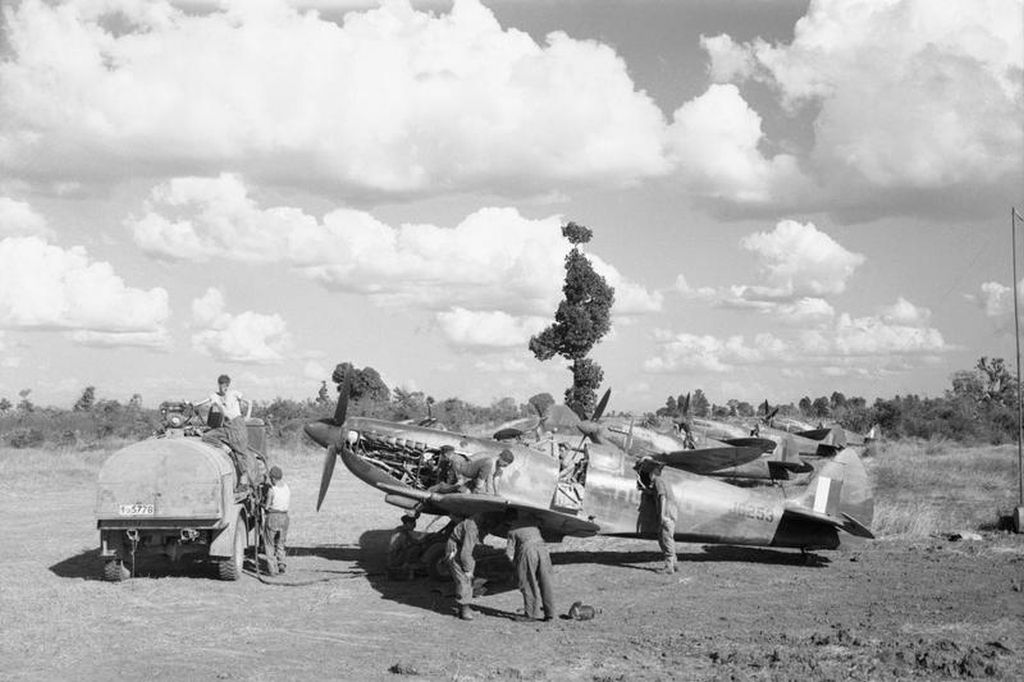
-
 Main Admin
Main Admin -
9 years agoSun Feb 14 2016, 07:05pm
 Main AdminText by Joe Baugher. Thanks
Main AdminText by Joe Baugher. Thanks
The Lockheed P-80 Shooting Star was the first American combat-ready jet fighter, and was the first American production combat aircraft to exceed 500 mph in level flight. It was the first American jet-powered aircraft to score a victory in air-to-air combat, and was the victor in the world's first jet-versus-jet combat. It participated in the world's first operational combat mission that was assisted by mid-air refuelling. For a brief time, it held the world's air speed record. And perhaps most significant, it formed the basis of the T-33 two-seat advanced trainer, one of the most successful trainers of the postwar era.
The USA got off to a late start in the new field of jet propulsion. The Germans had pioneered jet propulsion with the Heinkel He 178 V1, which was flown for the first time on August 27, 1939. The world's first jet-powered fighter, the Heinkel He 280 V1 flew for the first time on April 2, 1941. The Messerschmitt Me 262 V-3 took to the air under jet power for the first time on July 8, 1942. The British were not far behind the Germans, the Gloster E.28/39 experimental testbed having been flown for the first time on May 15, 1941 powered by a Whittle W2B turbojet engine with centrifugal supercharger. The Gloster Meteor flew for the first time on March 5, 1943, powered by a pair of 1500 lb.s.t. Halford H.1 turbojets. The prototype de Havilland DH-100 Vampire flew on September 21, 1943, powered by a single 2700 lb.s.t. Halford H.1 (Goblin) turbojet.
As far back as 1939, Lockheed engineers Clarence R. "Kelly" Johnson and Hall L. Hibbard had been interested in jet propulsion for aircraft, and had actually engaged in various paper projects. In particular, Lockheed had done some preliminary work on a company-financed project designated L-133 which had progressed to several different versions on the drawing board, culminating in the Model L-133-02-01, which was a canard design powered by a pair of Lockheed-designed L-1000 turbojet engines. The USAAF was not particularly interested in any of these projects and declined to finance any of them, so none of them ever progressed past the preliminary concept stage. However, spurred by reports from England on progress there with jet propulsion, and perhaps even more so by intelligence reports of German and Italian advances in the area of jet propulsion, the USAAF suddenly began to show more interest in jet-powered combat aircraft.
In exchange for the generous Lend-Lease aid provided to England by the USA, the British agreed to supply blueprints of their new jet engines to the USA, where they would be built under license by General Electric. Powered by a pair of General Electric I-A turbojets, the Bell XP-59A Airacomet made its maiden flight on October 19, 1942. Although the XP-59A provided valuable experience to the USAAF in the operation of jet-powered aircraft, it was basically a flying testbed and not a combat-capable aircraft. The USAAF had to look elsewhere in its search for an effective jet fighter.
In light of its pioneering work on the XP-59A Airacomet, the Bell Aircraft Corporation might have been a more likely choice than Lockheed for work on a more combat-capable jet fighter. However, the Bell corporation was heavily committed to other projects and could not take on any more work. In view of Lockeed's earlier studies in jet propulsion, in late 1942, the USAAF transferred to Lockheed the preliminary design studies undertaken by Bell for the XP-59B single-engined version of the Airacomet. In March of 1943, the specifications and drawings for the Halford H.1B (Goblin) turbojet were also transferred to Lockheed. This engine was to built under license in the USA by Allis-Chalmers as the J36.
In the spring of 1943, preliminary discussions were carried out between Lockheed representatives and the Air Technical Service Command about the production of a combat-capable jet fighter. On May 17, 1943, a conference chaired by Brig-Gen Franklin O. Carroll, chief of the Army Air Forces Engineering Division formalized these preliminary discussions. Lockheed was invited to submit a fighter proposal built around the de Havilland-built Halford H.1B turbojet. Immediately afterwards, Lockheed undertook a preliminary design investigation for a jet fighter project named L-140 by the company. On June 17, 1943 the USAAF gave its approval to the L-140 project, and on June 24 a formal Letter Contract was issued. The designation XP-80 was chosen for the project. On October 16, a formal contract was issued. One of the key requirements imposed on Lockheed was the need to complete the first aircraft within 180 days of the award of the Letter Contract.
In order to meet this schedule, Clarence L. "Kelly" Johnson, assisted by William P. Ralston and Don Palmer, assembled a small team of engineers and went to a ten-hour day/ 6-day week schedule. They housed themselves in a temporary building near the wind tunnel at Plant B-1 and set out to design the L-140 and to build the prototype XP-80 in record time and in complete secrecy. They operated almost completely outside the normal company bureaucracy, and proceeded with a minimum of paperwork and overhead. This was the origin of the famous Skunk Works.
The Skunk Works team adopted a simplistic approach. The team settled on a clean aircraft with a low aspect ratio, laminar-flow wing. Conventional tail surfaces and a retractable nosewheel undercarriage were adopted. The Halford H.1B engine was to be fed by air intakes positioned in the lower fuselage forward of the wing leading edge and exhausted through a straight tailpipe. The pilot sat in a pressurized cockpit underneath a rearward-sliding bubble canopy. The aft fuselage with engine and tail surfaces was detachable as a single unit for ready access to the powerplant. The armament was to consist of six 0.50-inch machine guns, all mounted in the nose.
The mockup of the XP-80 was ready for inspection on July 20-22, 1943. Only a few minor changes were recommended by the inspectors, and construction of the XP-80 (serial number 44-83020) proceeded rapidly. Since the project had the highest priority, construction went so rapidly that the XP-80 was soon ahead of schedule. The pressurized cockpit was considered unnecessary for the first prototype, so it was decided that an unpressurized cockpit would be fitted in order to save time. However, the jet engine program did not proceed quite so rapidly and the delivery from England of the first non-flyable turbojet was delayed several times, forcing Lockheed to use a wooden engine mockup for the first tests.
The non-flyable engine was finally delivered on November 2, 1943. This engine was installed in the XP-80, and the aircraft was trucked from Burbank to Muroc Dry Lake. On November 16, the XP-80 was formally accepted by the USAAF, beating the schedule by completing the aircraft within 143 days from the date of award of the Letter Contract.
While the XP-80 was still under construction, some consideration had been given to installing a less powerful General Electric I-16 (license-built Whittle W2B) jet engine for initial testing, with production aircraft being powered by the more powerful Halford H.1B built under license by Allis-Chalmers as the J36. However, the XP-80 would be decidedly underpowered with the I-16, and this idea was dropped.
However, the J36 program ran into difficulties and ultimately failed to produce anything useful. In September 1943, Lockheed proposed as an alternative a larger and heavier L-141 version, to be powered by a General Electric I-40 (later produced by both General Electric and Allison as the J33). The USAAF was sufficiently impressed that they issued a contract for two XP-80As. Serials were 44-83021 and 44-83022.
A flyable Halford engine was delivered to Lockheed in mid November of 1943. The de Havilland-built Halford H.1B turbojet had a bench thrust of 3000 pounds at 10,500 rpm and an installed thrust of 2460 pounds at 9500 rpm. On November 17, 1943, while the H.1B engine installation in the XP-80 was undergoing ground testing, both intake ducts collapsed, and the ingestion of debris damaged the engine. While waiting a replacement engine, the ducts were strengthened. The British selflessly rushed over a replacement engine which had been intended for the number 2 Vampire fighter. The replacement engine arrived on December 28 and was promptly installed in the XP-80. The XP-80 was finally ready for its maiden flight.
The first flight of the XP-80 took place on January 8, 1944 with test pilot Milo Burcham at the controls. The first flight had to be cut short after only five minutes because of undercarriage retraction failure and the pilot's concern over boosted aileron sensitivity. These problems were quickly fixed. Subsequent test flights reached a top speed of 502 mph at 20,480 feet, the XP-80 becoming the first USAAF aircraft to exceed 500 mph in level flight. However, the flight tests also disclosed a number of problems including bad stall and spin characteristics, an excessively-high stick force, unsatisfactory fuel management systems, and poor engine reliability and performance. At low speeds, it had a tendency to stall and roll sharply to the right with little or no warning. These problems were addressed one-by-one. The original blunt-tipped wing and tail surfaces were replaced with rounded tips after the fifth flight, and sharp leading edge fillets were added at the wing roots. The tailplane incidence was increased by 1 1/2 degrees.
The XP-80 weighted 6287 pounds empty and 8196 pounds loaded. Dimensions were wingspan 37 feet 0 inches, length 32 feet 10 inches, height 10 feet 3 inches, and wing area 240 square feet. During tests, the XP-80 reached a top speed of 502 mph at 20,480 feet, becoming the first USAAF aircraft to exceed 500 mph in level flight. Service ceiling was 41,000 feet, and initial climb rate was 3000 feet per minute. The aircraft was armed with six 0.50-inch Browning M2 machine guns with 200 rounds per gun.
The XP-80 was eventually transferred to the 412th Fighter Group for tactical evaluation. Following that, the aircraft was returned to Muroc before being assigned to the AAF Training Command at Chanute Field in Illinois. The XP-80 survived all of these evaluation trials, and on November 8, 1946, it was transferred to the Smithsonian Institution for eventual display. Restoration work was completed in May of 1978.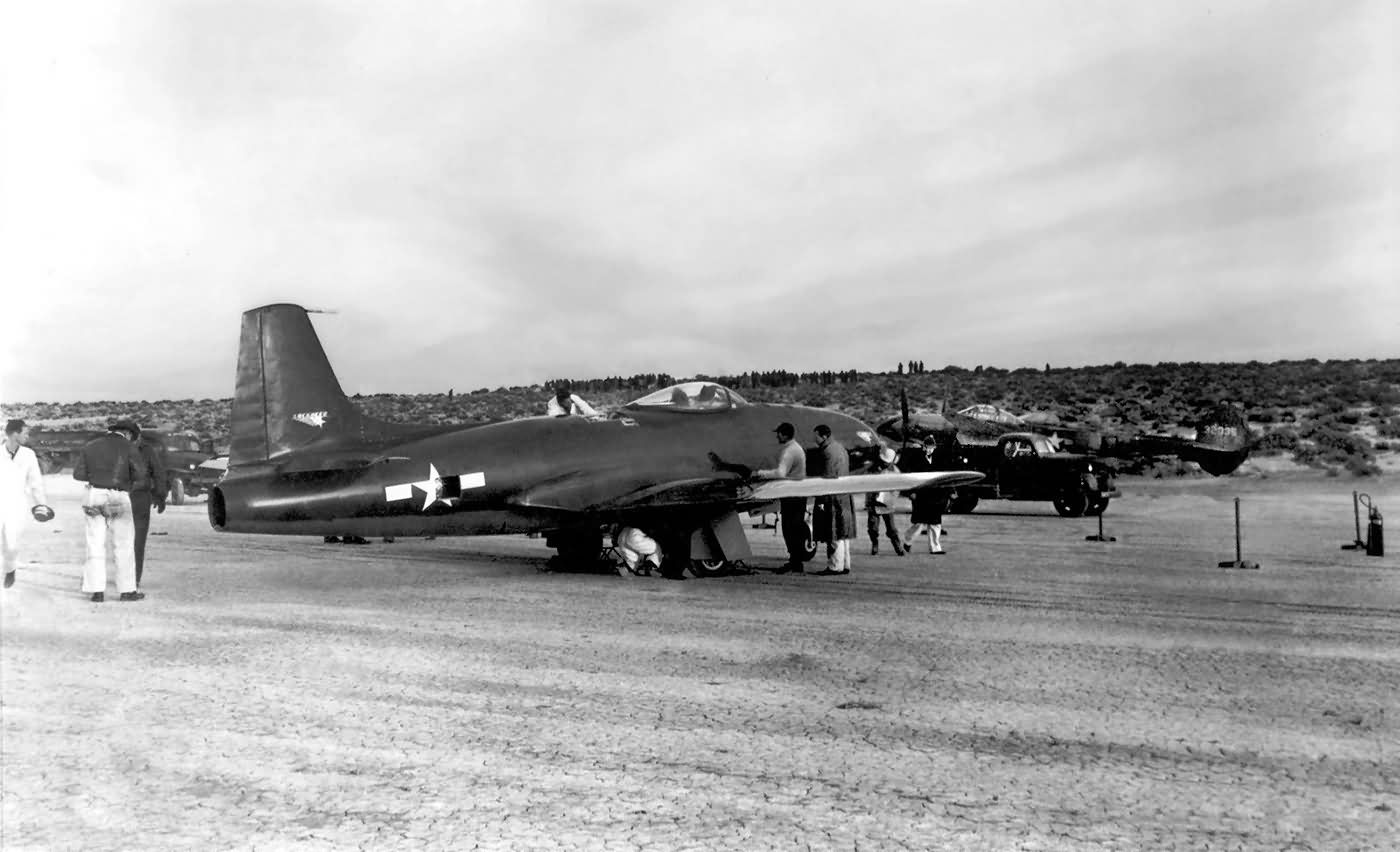

The second prototype, designated XP-80A, was designed for the larger General Electric I-40 engine (an improved Rolls-Royce Derwent, later produced by Allison as the J33). Two aircraft (44-83021 and 44-83022) were built. 44-83021 was nicknamed the Gray Ghost after its "pearl gray" paint scheme, while 83022, left unpainted for comparison of flight characteristics, became known as the Silver Ghost. The XP-80A's first test flight was unimpressive, but most of the problems with the design were soon addressed and corrected in the test program. Initial opinions of the XP-80A were not positive, with Lockheed Chief Engineering Test Pilot Milo Burcham commenting that an aircraft he very much enjoyed (powered by the Halford engine) had now become a "dog." The XP-80As were primarily testbeds for larger, more powerful engines and air intake design, and consequently were larger and 25% heavier than the XP-80.
The P-80 testing program proved very dangerous. Burcham was killed on 20 October 1944 while flying the third YP-80A produced, 44-83025. The Gray Ghost was lost on a test flight on 20 March 1945, although pilot Tony LeVier escaped. Newly promoted to chief engineering test pilot to replace Burcham, LeVier bailed out when one of the engine's turbine blades broke, causing structural failure in the aircraft's tail. LeVier landed hard and broke his back, but returned to the test program after six months of recovery. The top-scoring World War II USAAF ace Major Richard Bong was also killed on an acceptance flight of a production P-80 in the United States on 6 August 1945. Both Burcham and Bong crashed as a result of main fuel pump failure. Burcham's death was the result of a failure to brief him on a newly installed emergency fuel pump backup system, but the investigation of Bong's crash found that he had apparently forgotten to switch on this pump, which could have prevented the accident. He bailed out when the aircraft rolled inverted but was too close to the ground for his parachute to deploy.
Tony LeVier?s parachute was swinging and he was severely injured when he hit the ground. His injuries kept him from flying for the next six months.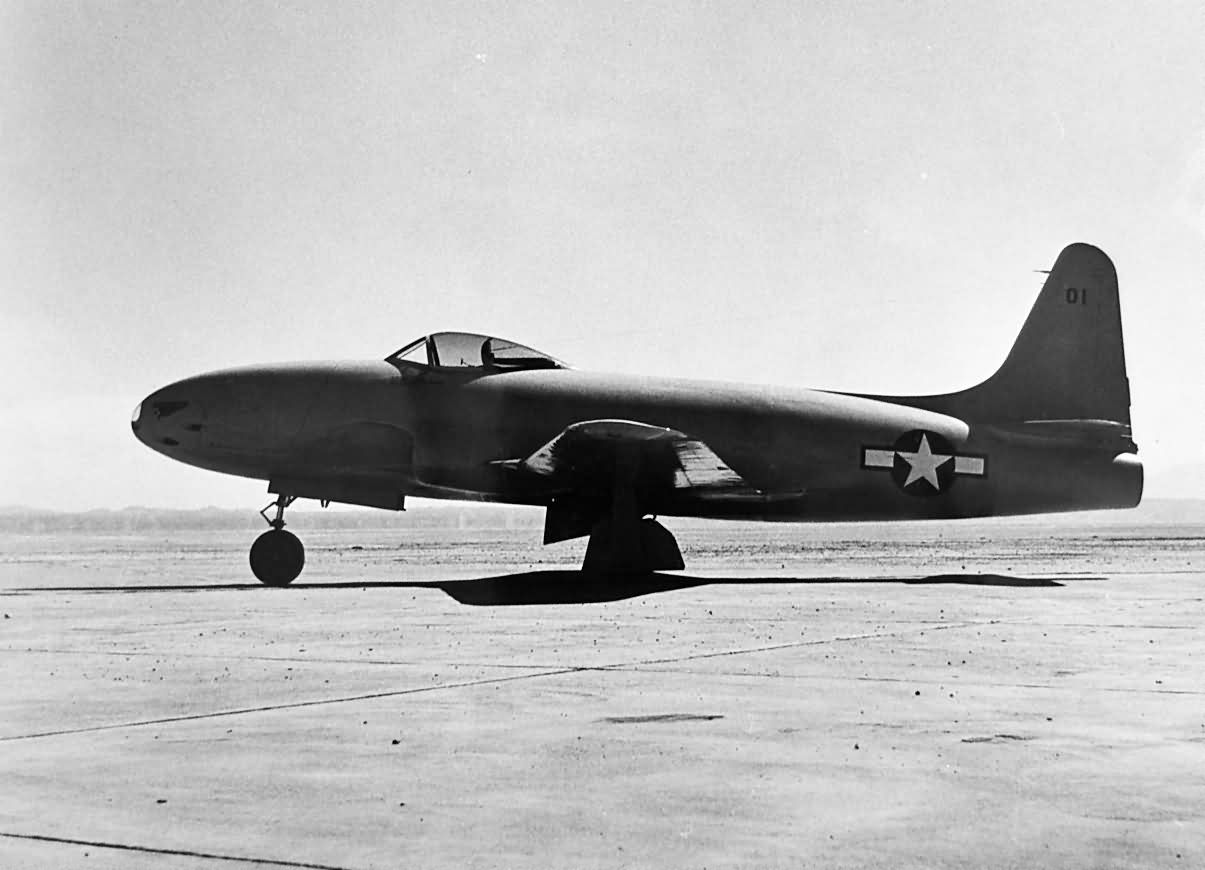
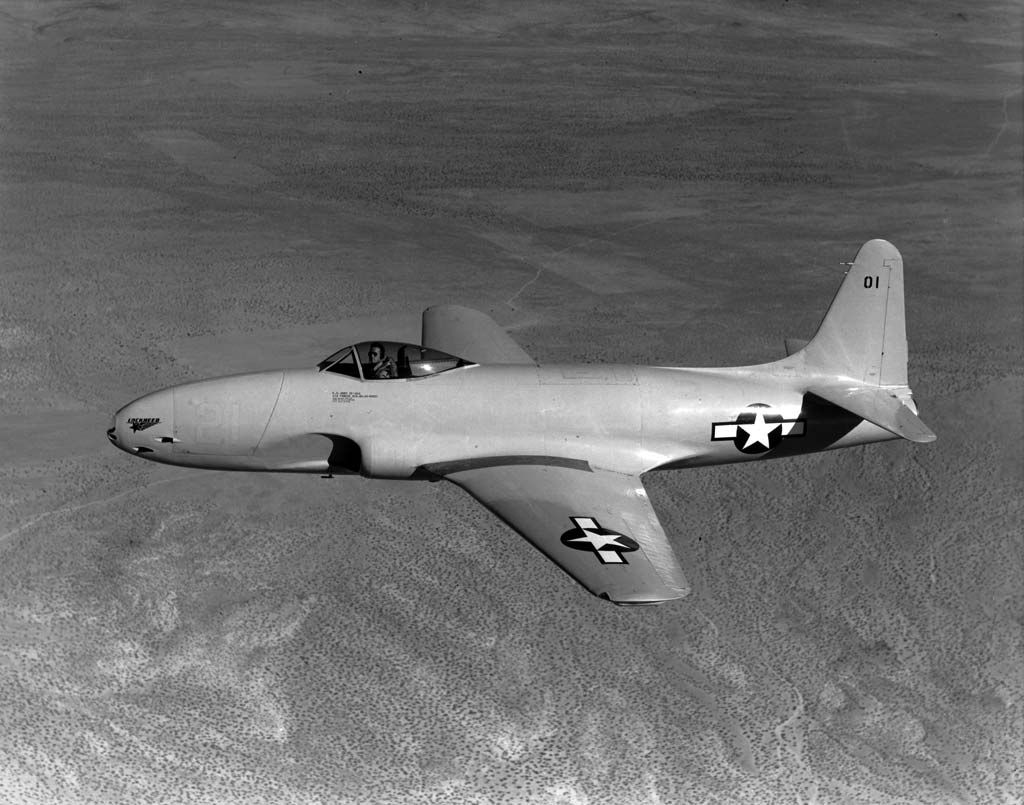
-
9 years agoSun Nov 29 2015, 11:50am
 Main Admin
Main Admin -
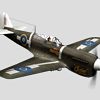 Admin
Admin
Some great shots you've been posting recently Alan. I especially like this one as it's bit rare because it shows the oblique camera installation on the TacR Hurricanes.
Duggy
A Republic P-47D Thunderbolt of the 80th Fighter Group, 10th USAAF, taxies past Hawker Hurricane Mark IIC, LB395 'L' of No. 34 Squadron RAF, at Palel, Burma.
-
 Main Admin
Main Admin -
 Main AdminEight this week
Main AdminEight this week
Of Col. George R. Bickell, Nutley, NJ, Commanding Officer of the 9th AF, and his ride.
P-51B Mustang (GQ-A, serial number 43-12173) nicknamed "Peg O' My Heart" of the 355th Fighter Squadron, 354th Fighter Group, 15 December 1943.
Associated Press Photos
"'The P-51B - World's Fastest Fighter Plane. A new single-engined figher 'plane, the P-51B, is now escorting Flying Fortresses in raids over Germany. A new, improved version of the Mustang which has been used with such success by the R.A.F., this, the newest aircraft to be used in the European Theatre of Operations, is the longest-range, single-engined fighter plane in the world and one of the fastest. The main differences between it and the Mustang are that it has a Rolls Royce Merlin engine instead of the Allison engine and the addition of auxiliary wing-tanks which increase its range as a high-altitude fighter."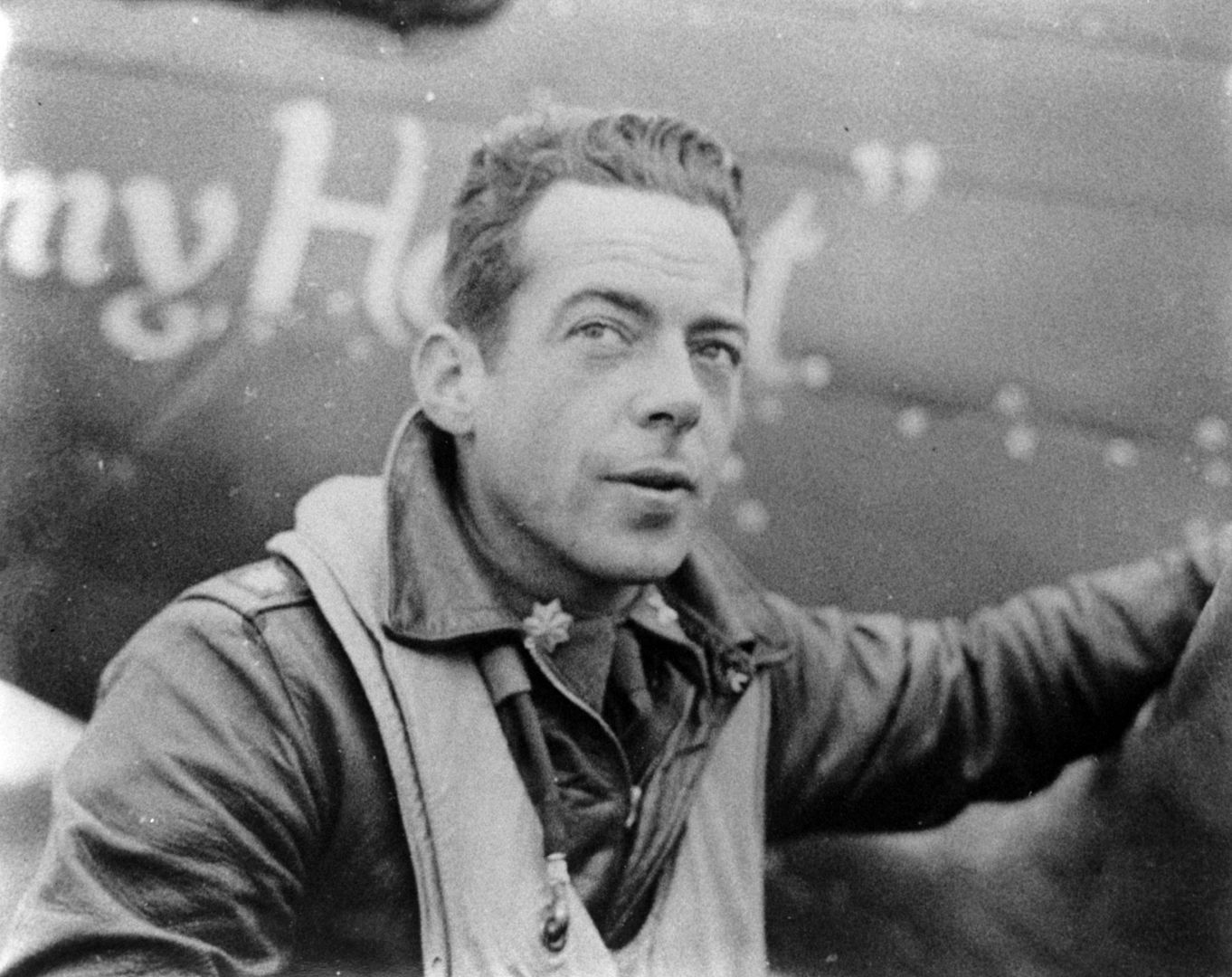


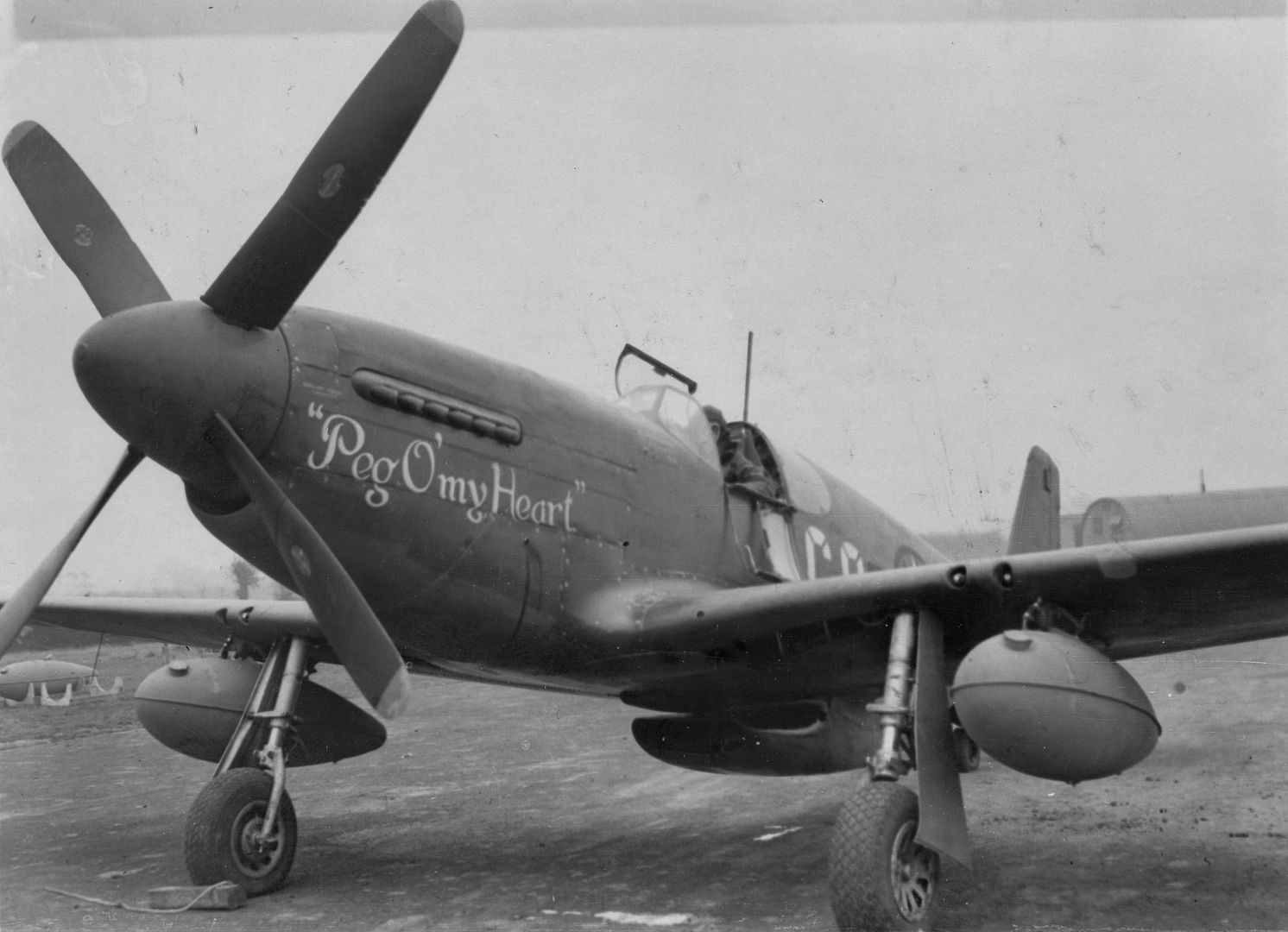
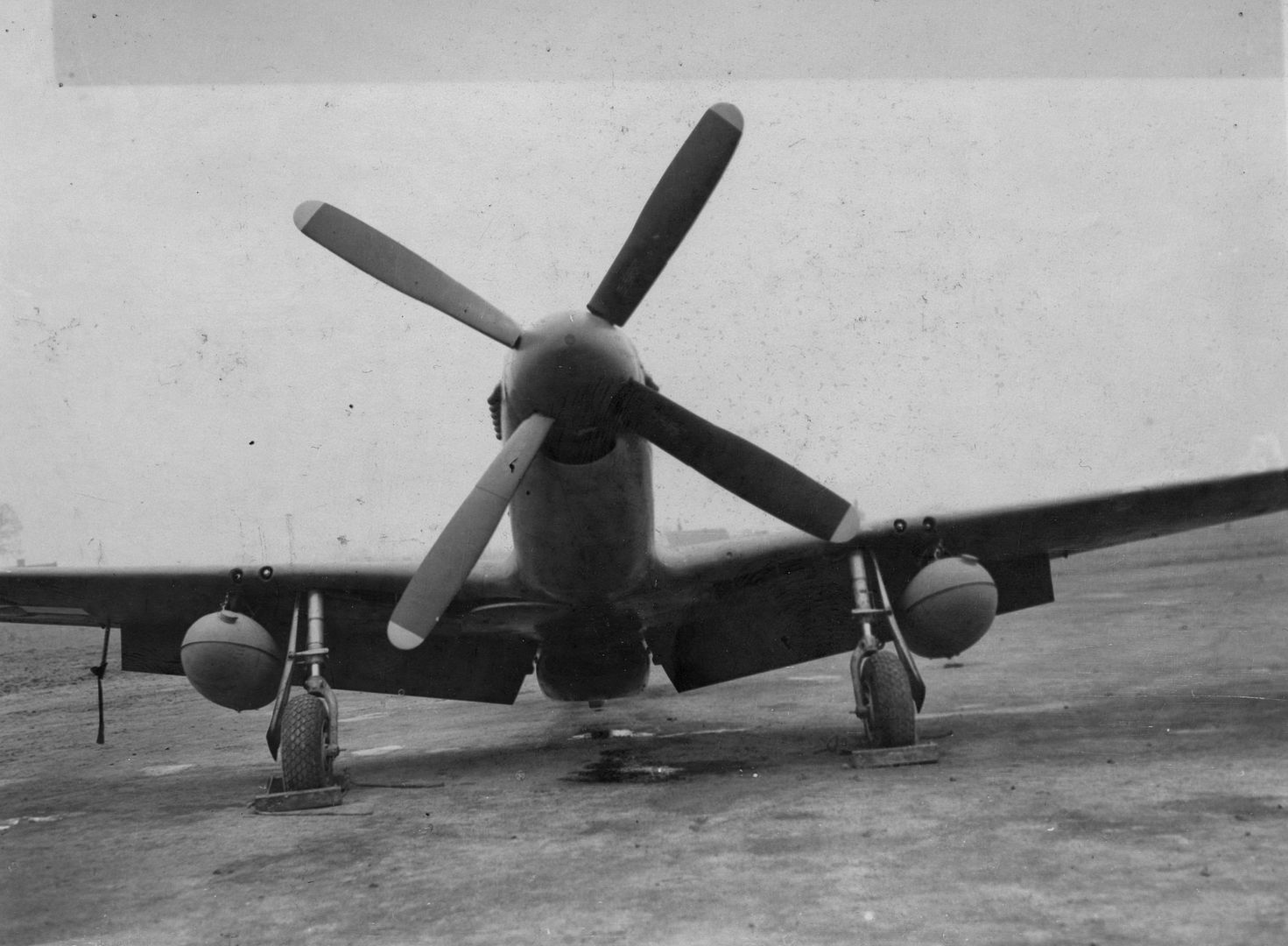
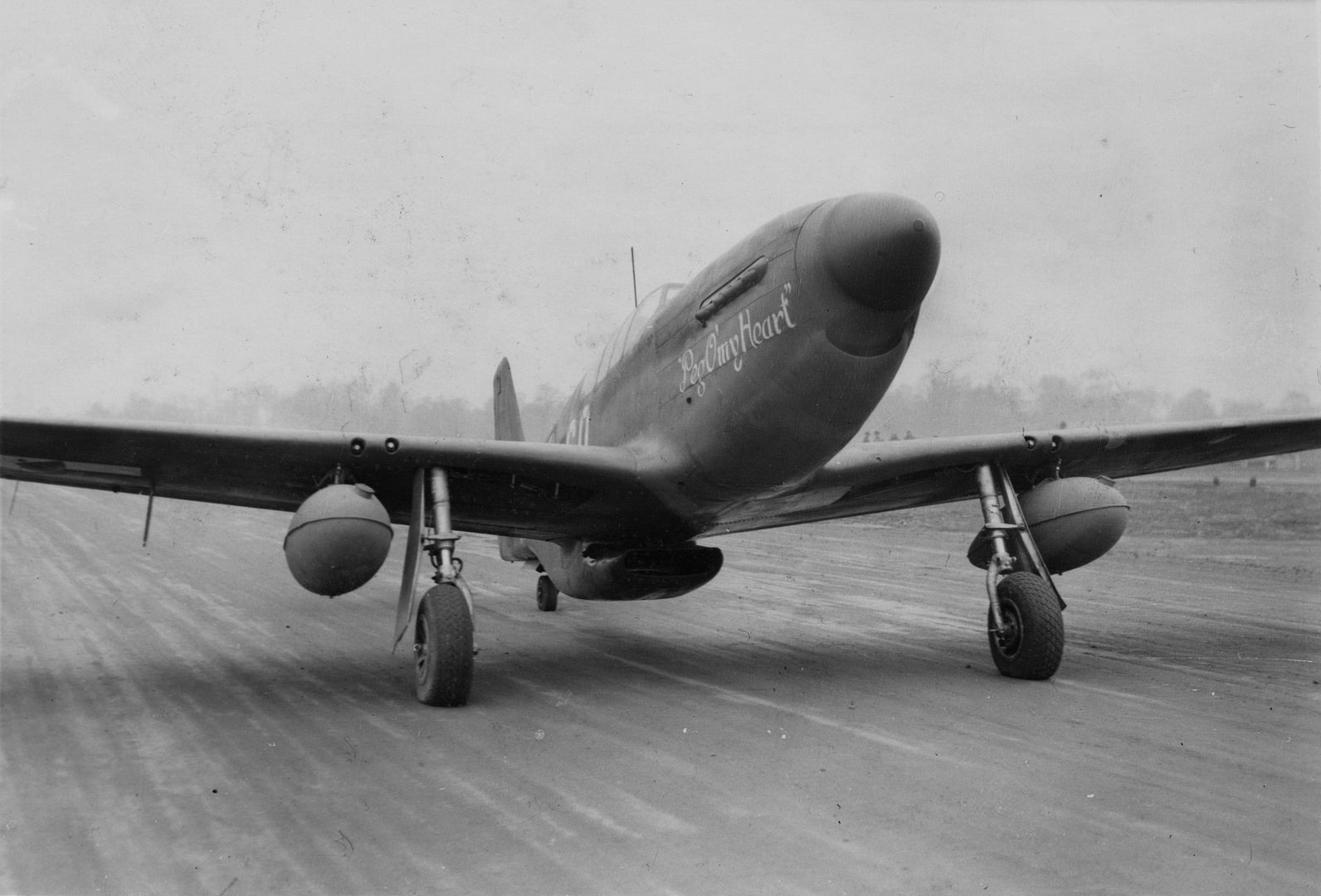
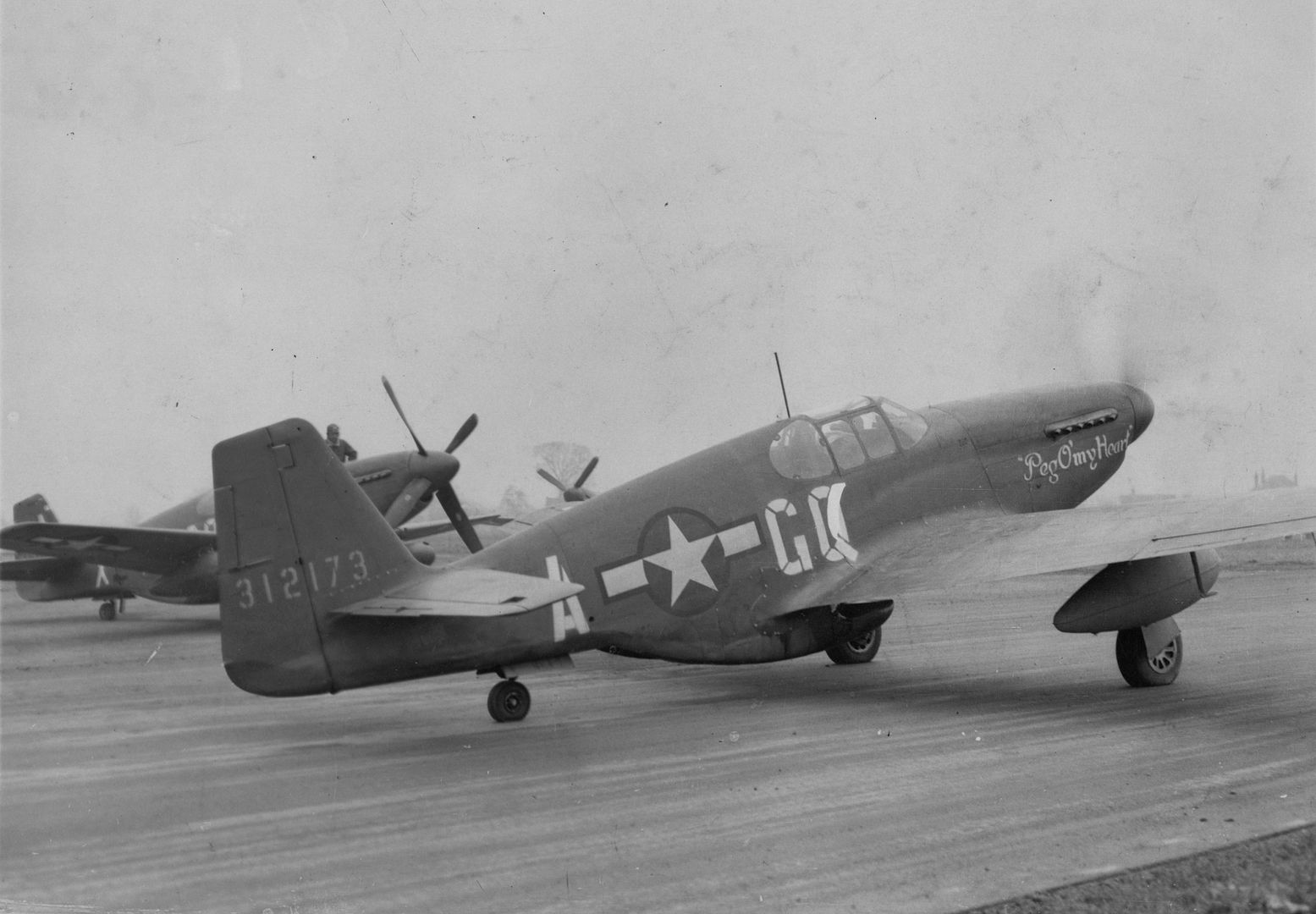
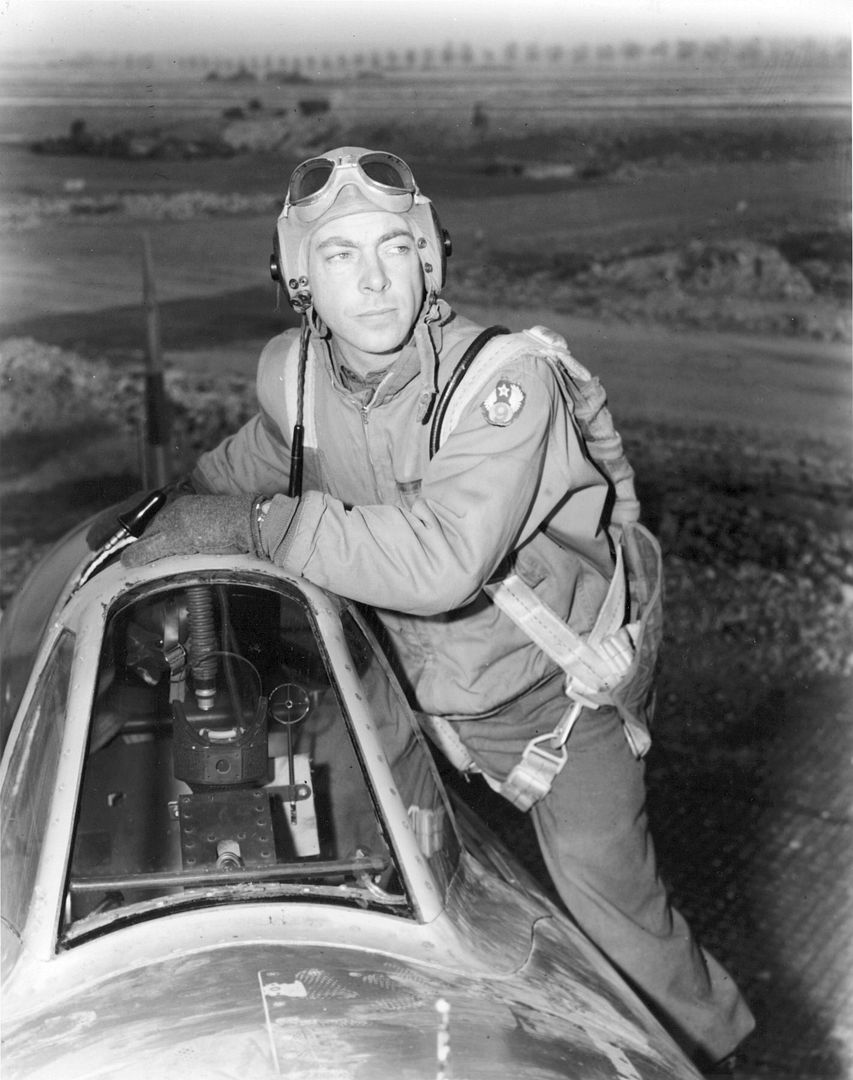
-
 Main Admin
Main Admin -
 Main AdminMid week bonus.
Main AdminMid week bonus.
Two fantastic factory photo's of Avia B-534 fighter's.
A No IV batch Avia B-534 fighter biplane. The cockpit was covered by a canopy and hooded wheels. Aircraft of all the batches were equipped with racks for small splinter bombs.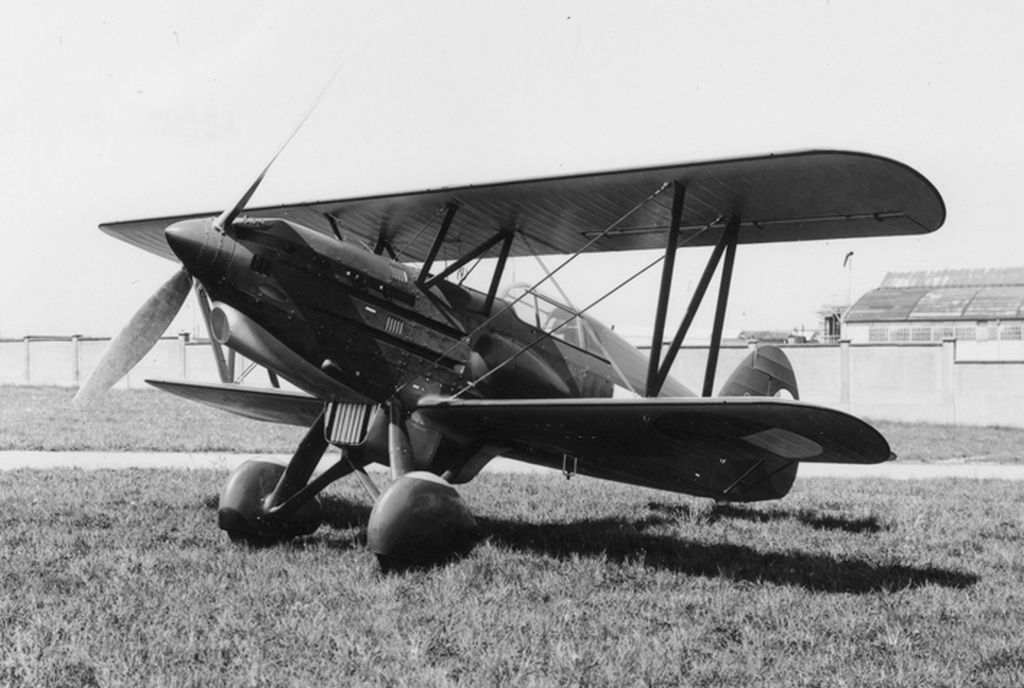
A 190th production B-534 fighter, the fourth one armed with four machine guns. The machines being turned out from 1936 were of higher empty as well as take-off weight, top speed, service ceiling and climb up to 5 000 m. Two machine guns typical for the first 100 pcs batch in the lower wing were mounted into both sides of the fuselage.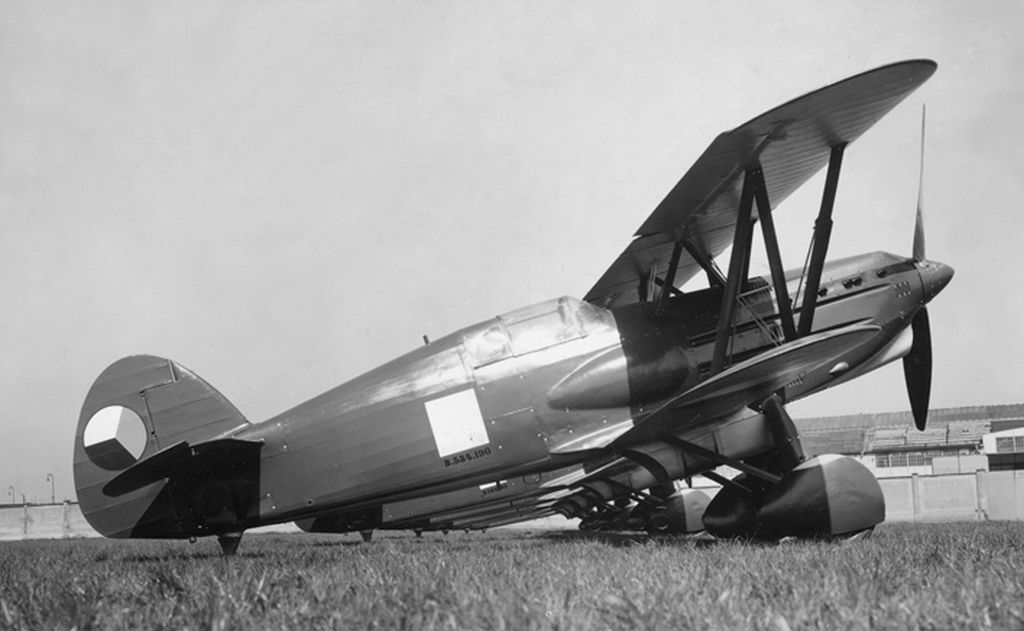
-
 Main Admin
Main Admin
Post a reply
- Go to Next topic
- Go to Welcome
- Go to Introduce Yourself
- Go to General Discussion
- Go to Screenshots, Images and Videos
- Go to Off topic
- Go to Works in Progress
- Go to Skinning Tips / Tutorials
- Go to Skin Requests
- Go to IJAAF Library
- Go to Luftwaffe Library
- Go to RAF Library
- Go to USAAF / USN Library
- Go to Misc Library
- Go to The Ops Room
- Go to Made in Germany
- Go to Campaigns and Missions
- Go to Works in Progress
- Go to Juri's Air-Raid Shelter
- Go to Campaigns and Missions
- Go to Works in Progress
- Go to Skinpacks
- Go to External Projects Discussion
- Go to Books & Resources
